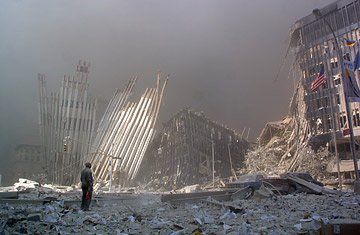
A man stands in the rubble, and calls out asking if anyone needs help, after the collapse of the first World Trade Center Tower in New York City on September 11, 2001.
(4 of 10)
As McMillan was racing downtown, Michelle March, 29, an emergency medical technician, was heading into Manhattan in her ambulance. She was among the first EMTs to arrive in front of the south tower. Then hell descended, and March ran. "I noticed that the debris was picking people up and slamming them into buildings. So I grabbed a pole and held on for dear life," even as the oddments of a skyscraper struck her. "I told God, 'I'm not dying today,' so I held on no matter how many bricks were hitting me. I felt ash go down my throat, so I made myself vomit because it was asphyxiating. My head was hurting from the hits, but I refused to lose consciousness." And she did not. She spent only one night in the hospital. One of the other EMTs with whom she worked died; another is missing.
There were smaller but no less precious miracles. Nishikant Kapatker, a city planner for the Port Authority, went in at 8:30 a.m., a half-hour early because he and his wife Jaya, who worked in the nearby American Express Building, expected to go on vacation that evening. Thrown from his chair by the impact of Flight 11, he quickly made his way downstairs, watching 20 or 30 fire fighters climbing up, huffing and puffing toward death.
Once outside, he saw the body parts on the plaza, the war zone. He went looking for his wife. Both the building where she worked and the one where they live had been evacuated. It was almost 11 a.m. when he finally saw her. "She was sitting on a bench all alone, her head down," he says. She was praying and meditating. Nishikant put his hand on Jaya's shoulder. "And she cried like a baby for a long time." A miracle is worth at least that many tears. --By John Cloud. With reporting by Unmesh Kher and Desa Philadelphia
A Hovering Spirit
For a few brief moments on Tuesday morning, Irish architect Ronnie Clifford, 47, was twice blessed: as both hero and survivor of the terrorist attacks. Standing in the lobby of the Marriott Hotel after the first plane hit, Clifford saw a charred woman rise from the pyre, her fingernails melting off and her clothes burned onto her skin. He was shielding her with his coat when a second shudder sent them to the floor. To keep her from drifting off, they conversed and prayed. She told him her name, Jennieann Maffeo, and the name and number of her boss at Paine Webber; she also told him she was asthmatic and allergic to latex. Clifford took copious notes. With the help of a Marriott employee and oxygen from the hotel's medical kit, Clifford led her to the nearest ambulance. Maffeo's charred skin still clinging to his coat, Clifford ran west and hopped on a ferry back to his home in Glen Ridge, N.J., where he hugged his wife and daughter, who was celebrating her 11th birthday on Sept. 11.
Only then did he learn he was also thrice cursed. He had lost family members: Clifford's sister, Ruth McCourt, 45, and his niece Juliana, 4, had been aboard the United Airlines flight that plowed through 2 World Trade Center. He had also lost a family friend: Paige Farley Hackel, 46, who was meeting McCourt in Los Angeles but traveling separately on the American Airlines flight that crashed into the other tower. Hackel, a spiritual counselor, was heading to Los Angeles for a seminar with Deepak Chopra. McCourt was taking her daughter on a surprise trip to Disneyland.
